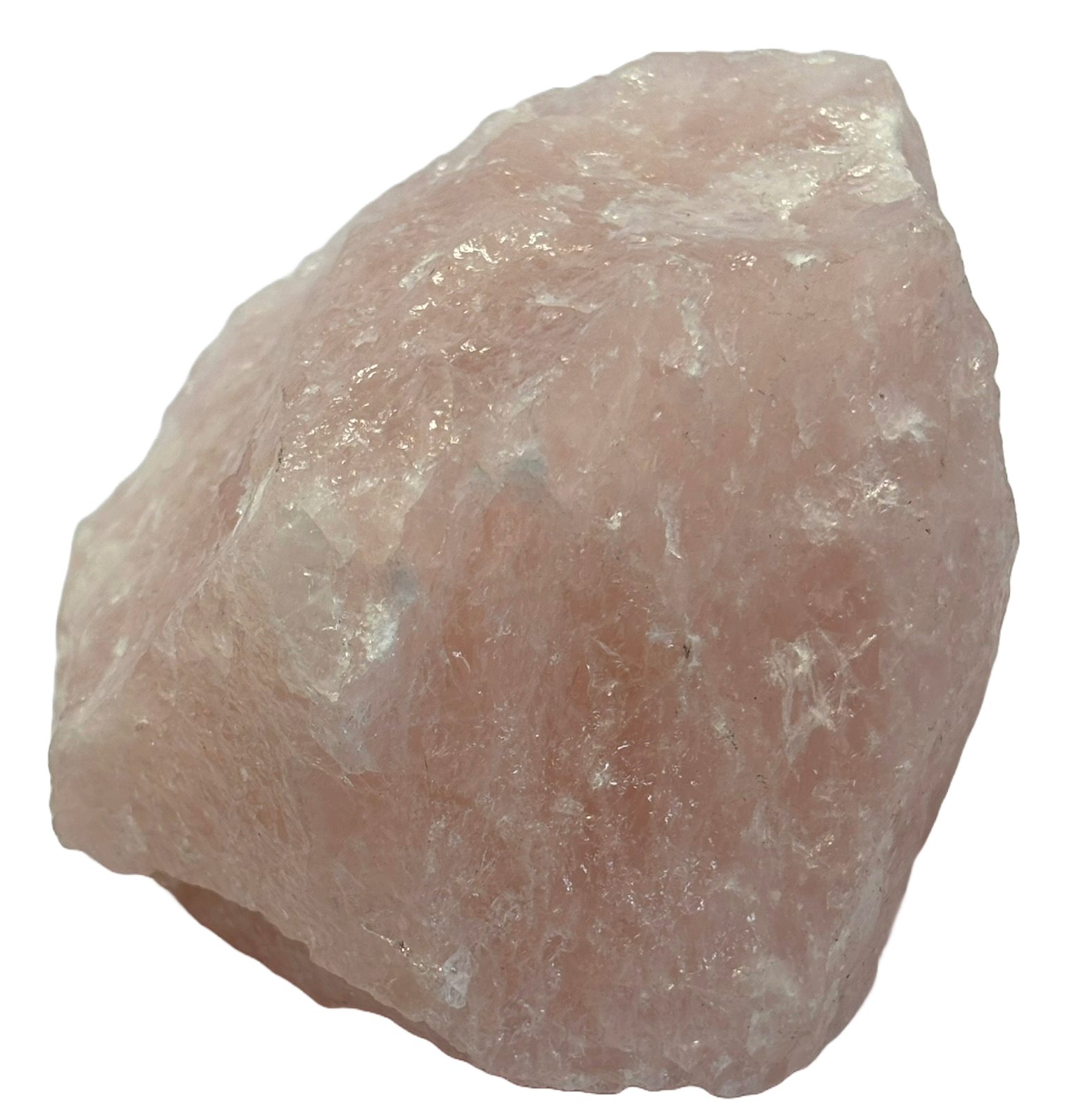
Rose Quartz, a stone renowned for its delicate pink hue and metaphysical allure, has captured the hearts and minds of people for centuries. This comprehensive article delves into its origins, composition, geographical locations, historical significance, fascinating facts, and its role in mythology, healing, and spirituality.
Origins of Its Name and Alternate Names
The name “Rose Quartz” is derived from its soft pink colour, reminiscent of a rose in bloom. The term “quartz” comes from the German word quarz, which traces back to Slavic origins, meaning “hard.”
Throughout history, Rose Quartz has also been referred to as “hyaline quartz,” from the Greek word hyalos, meaning “glass-like.” In some cultures, it is known as the “love stone” or “heart stone,” signifying its association with unconditional love and emotional healing.
Composition and Physical Characteristics
Rose Quartz is a variety of quartz, composed primarily of silicon dioxide (SiO₂). Its pink colour results from trace amounts of titanium, iron, or manganese within its crystal lattice.
Physical Characteristics and Varieties:
- Appearance: Typically translucent to opaque, with a vitreous (glass-like) lustre.
- Colours: Shades range from pale pink to deep rose.
- Texture: Often smooth with a uniform colour, though some varieties display asterism (star-like patterns) under light.
A notable variety is “Star Rose Quartz,” which contains microscopic rutile inclusions, creating a stunning star effect when polished.
Geographical Locations
Rose Quartz is found in various regions worldwide, particularly where quartz-rich environments exist. Major sources include:
- Brazil: Known for high-quality and abundant deposits.
- Madagascar: Home to richly coloured, translucent specimens.
- United States: Found in South Dakota and California.
- India: Produces beautiful cabochon-grade stones.
- South Africa: Renowned for industrial and ornamental-grade varieties.
Historical and Current Usage
Rose Quartz has been cherished since antiquity. Archaeological evidence suggests its use as far back as 7,000 BCE, where it was carved into amulets, beads, and figurines.
In Ancient Egypt, it was believed to prevent ageing, while the Romans used it as a seal to signify ownership. During the Middle Ages, it was regarded as a token of love and reconciliation.
In modern times, Rose Quartz is widely used in jewellery, decorative objects, and holistic practices. Its association with self-care and love has made it a popular choice for skincare tools, such as facial rollers.
Interesting Facts
- Rose Quartz is one of the most common and widely used varieties of quartz.
- It has been deemed a universal stone of love across cultures and eras.
- The La Madona Rosa, an exquisite Rose Quartz specimen weighing over 15 tons, is one of the most famous examples.
Folklore, Superstition, Legends, and Tales
Rose Quartz has been the subject of legends and myths across the world, often celebrated for its connection to love, healing, and divine energy.
Europe
In Greek mythology,Aphrodite, the goddess of love and her mortal lover, Adonis. It is said that Adonis was attacked by a wild boar while hunting. In her haste to save him, Aphrodite ran through a forest, cutting herself on brambles. Their mingled blood fell upon white quartz, staining it pink and transforming it into what we now know as Rose Quartz.
Explore the enchanting Rose Quartz, a pink gemstone of love, healing, and harmony. Learn its history, properties, folklore, and spiritual significance.
In Egyptian lore, Rose Quartz was prized as a beautification aid. Ancient Egyptians believed that the stone held anti-ageing properties and used it in facial masks to promote youthful and radiant skin. It was also buried with the dead to ensure a harmonious afterlife, as the stone symbolised peace and reconciliation.
East
In Tibetan and Chinese cultures, Rose Quartz was known as a talisman of unconditional love. It was often carved into heart-shaped pendants or figurines and exchanged as tokens of affection and friendship. These cultures associated it with emotional healing and the energy of the heart, viewing it as a bridge between the physical and spiritual realms.
A legend from Japan tells that the gods created the stone to shield true love from jealousy and harm. It was said that carrying Rose Quartz would invoke the blessing of Amaterasu, the Sun Goddess, for happiness and prosperity in relationships.
Americas
Explore the enchanting Rose Quartz, a pink gemstone of love, healing, and harmony. Learn its history, properties, folklore, and spiritual significance.
Mystical Healing Properties
Rose Quartz is often regarded as the ultimate healing crystal for the heart. Its mystical properties include:
- Emotional Healing: Promotes self-love, forgiveness, and inner peace.
- Physical Healing: Associated with skin rejuvenation and heart health.
- Spiritual Healing: Enhances meditative states and harmonises energy fields.
Astrological Links and the Chakra System
Rose Quartz is linked to the heart chakra, aligning emotional, physical, and spiritual aspects of love. It resonates with the zodiac signs Taurus and Libra, ruled by Venus, the planet of love and beauty. This association enhances its powers of harmony and attraction.
Use as a Birthstone and Wedding Anniversary Gift
Although not an official birthstone, Rose Quartz is often gifted as a token of love for January birthdays.
As a wedding anniversary gift, it is traditionally associated with the 5th anniversary, symbolising compassion, trust, and enduring love.

Rose Quartz
Rose Quartz opens the heart to love, healing, and emotional peace. A gentle crystal that fosters compassion, self-acceptance, and nurturing connections.
